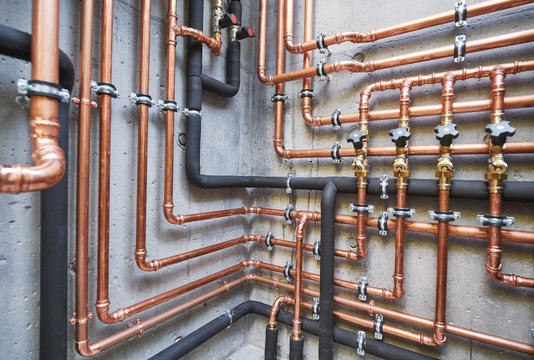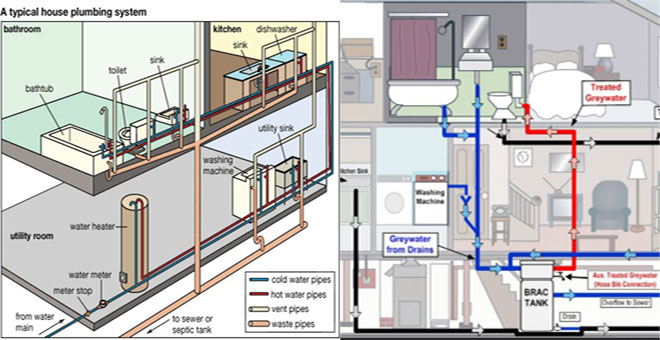Everything You Need to Know to Your Home's Plumbing System Anatomy
Everything You Need to Know to Your Home's Plumbing System Anatomy
Blog Article
Here in the next paragraphs yow will discover a good deal of sensible expertise with regards to The Inner Workings of Your Home's Plumbing.

Comprehending just how your home's pipes system functions is necessary for every single home owner. From supplying clean water for drinking, cooking, and bathing to safely removing wastewater, a well-kept pipes system is critical for your family members's wellness and comfort. In this comprehensive guide, we'll explore the intricate network that makes up your home's pipes and deal ideas on maintenance, upgrades, and dealing with typical issues.
Intro
Your home's pipes system is more than simply a network of pipes; it's a complicated system that ensures you have accessibility to clean water and reliable wastewater removal. Understanding its elements and how they work together can assist you prevent expensive fixings and make sure whatever runs smoothly.
Standard Elements of a Plumbing System
Pipes and Tubes
At the heart of your plumbing system are the pipes and tubes that bring water throughout your home. These can be made of numerous materials such as copper, PVC, or PEX, each with its advantages in regards to durability and cost-effectiveness.
Fixtures: Sinks, Toilets, Showers, and so on.
Fixtures like sinks, bathrooms, showers, and tubs are where water is used in your house. Comprehending exactly how these components attach to the pipes system helps in identifying issues and preparing upgrades.
Shutoffs and Shut-off Factors
Shutoffs regulate the circulation of water in your pipes system. Shut-off valves are important during emergencies or when you require to make repair services, enabling you to separate parts of the system without disrupting water flow to the entire home.
Water Supply System
Key Water Line
The major water line connects your home to the municipal water or a personal well. It's where water enters your home and is distributed to numerous components.
Water Meter and Stress Regulatory Authority
The water meter steps your water use, while a stress regulator guarantees that water flows at a secure pressure throughout your home's plumbing system, stopping damage to pipelines and components.
Cold Water vs. Hot Water Lines
Comprehending the difference in between cold water lines, which provide water straight from the major, and hot water lines, which bring heated water from the hot water heater, aids in fixing and planning for upgrades.
Drain System
Drain Piping and Traps
Drain pipelines carry wastewater far from sinks, showers, and toilets to the sewage system or septic system. Catches stop sewer gases from entering your home and likewise catch debris that might create clogs.
Air flow Pipelines
Air flow pipelines enable air right into the water drainage system, stopping suction that can slow drain and create catches to empty. Appropriate air flow is important for preserving the stability of your pipes system.
Significance of Proper Drainage
Making sure correct water drainage prevents backups and water damage. Regularly cleansing drains and maintaining catches can stop pricey repair work and extend the life of your pipes system.
Water Heater
Kinds Of Water Heaters
Water heaters can be tankless or traditional tank-style. Tankless heaters heat water on demand, while tanks save warmed water for prompt usage.
Just How Water Heaters Connect to the Pipes System
Comprehending exactly how hot water heater attach to both the cold water supply and warm water distribution lines helps in diagnosing issues like insufficient warm water or leaks.
Maintenance Tips for Water Heaters
On a regular basis flushing your water heater to eliminate debris, inspecting the temperature level setups, and checking for leakages can extend its lifespan and improve power efficiency.
Usual Plumbing Concerns
Leakages and Their Causes
Leakages can happen due to maturing pipes, loosened installations, or high water pressure. Attending to leakages quickly protects against water damages and mold development.
Clogs and Obstructions
Obstructions in drains and bathrooms are often triggered by flushing non-flushable things or a build-up of oil and hair. Using drainpipe displays and bearing in mind what goes down your drains pipes can stop blockages.
Signs of Pipes Troubles to Look For
Low water stress, slow-moving drains, foul odors, or unusually high water costs are indicators of prospective plumbing problems that should be resolved promptly.
Plumbing Upkeep Tips
Regular Assessments and Checks
Schedule annual pipes evaluations to capture problems early. Seek signs of leakages, corrosion, or mineral build-up in taps and showerheads.
DIY Maintenance Tasks
Easy tasks like cleansing faucet aerators, looking for commode leaks making use of dye tablet computers, or protecting revealed pipelines in chilly environments can prevent significant plumbing problems.
When to Call a Specialist Plumbing Technician
Know when a plumbing problem requires professional know-how. Attempting complicated fixings without proper understanding can cause even more damage and greater fixing costs.
Upgrading Your Plumbing System
Reasons for Updating
Updating to water-efficient fixtures or replacing old pipelines can boost water top quality, reduce water bills, and boost the worth of your home.
Modern Pipes Technologies and Their Benefits
Explore innovations like wise leakage detectors, water-saving commodes, and energy-efficient water heaters that can save money and decrease environmental effect.
Expense Factors To Consider and ROI
Determine the upfront prices versus long-lasting cost savings when considering plumbing upgrades. Many upgrades spend for themselves with decreased energy bills and fewer fixings.
Environmental Impact and Preservation
Water-Saving Components and Home Appliances
Installing low-flow faucets, showerheads, and commodes can significantly minimize water use without giving up efficiency.
Tips for Lowering Water Usage
Easy habits like taking care of leaks immediately, taking much shorter showers, and running complete loads of laundry and meals can conserve water and lower your energy costs.
Eco-Friendly Plumbing Options
Consider sustainable plumbing products like bamboo for floor covering, which is durable and environmentally friendly, or recycled glass for counter tops.
Emergency Preparedness
Actions to Take Throughout a Plumbing Emergency
Know where your shut-off shutoffs lie and just how to turn off the supply of water in case of a burst pipeline or major leakage.
Relevance of Having Emergency Get In Touches With Useful
Maintain get in touch with information for neighborhood plumbing professionals or emergency solutions conveniently offered for fast reaction throughout a pipes situation.
Do It Yourself Emergency Situation Fixes (When Relevant).
Temporary solutions like utilizing air duct tape to patch a leaking pipeline or positioning a container under a dripping tap can reduce damage till an expert plumber gets here.
Final thought.
Understanding the anatomy of your home's pipes system empowers you to keep it properly, saving money and time on repair work. By complying with routine maintenance regimens and staying educated regarding contemporary plumbing technologies, you can guarantee your plumbing system runs successfully for many years ahead.
Understanding Your Home Plumbing System: A Comprehensive Guide
Plumbing System: The Lifeline of Your Home
At its core, the plumbing system is designed to perform two primary functions: bring fresh water into your home and remove wastewater. The system is a network of pipes, fixtures, and other components that transport water and sewage. Residential plumbing systems include potable water supply lines, drain-waste-vent (DWV) systems, and various plumbing fixtures that make water use in daily tasks possible.
Key Components:
Water Supply: This part of your plumbing system brings municipal water into your home, passing through the main water supply line. It s responsible for supplying all water needs, from drinking to bathing.
Drainage System: It carries waste and water away from your home to the sewer or septic system. This system includes all the piping within your home that leads to external sewage or septic systems.
Vent System: An essential yet often overlooked component, the vent system allows sewer gases to escape and lets air into the drainpipes, ensuring water and waste move correctly through the system.
Fixture: More Than Just Taps and Toilets
Plumbing fixtures are the most interactive parts of the plumbing system, including faucets, showers, toilets, and sinks. Each fixture is connected to the plumbing system and plays a role in either the delivery of freshwater or the disposal of waste and wastewater.
Types of Fixtures:
Faucets and Sinks: Used for washing hands, dishes, and other daily water needs.
Toilets: Dispose of human waste through the sewage system.
Bathtubs and Showers: Provide bathing facilities, requiring both hot and cold water supply.
Water Supply: The Source of Life
The water supply system is a critical component, ensuring that potable water is available throughout your home for various uses, including drinking, cooking, and cleaning. This system consists of pipes that distribute water to different parts of the house, controlled by valves to regulate the water flow.
Types of Plumbing: Materials and Methods
Various types of plumbing systems and materials are used in residential settings, each with its advantages and applications. From copper and PVC pipes for water supply to cast iron and ABS for drainage, the choice of materials can impact the longevity and efficiency of your plumbing system.
https://intownplumbingtx.com/articles/home-plumbing-system-guide/

Understanding Your Home Plumbing System: A Comprehensive Guide
Plumbing System: The Lifeline of Your Home
At its core, the plumbing system is designed to perform two primary functions: bring fresh water into your home and remove wastewater. The system is a network of pipes, fixtures, and other components that transport water and sewage. Residential plumbing systems include potable water supply lines, drain-waste-vent (DWV) systems, and various plumbing fixtures that make water use in daily tasks possible.
Key Components:
Water Supply: This part of your plumbing system brings municipal water into your home, passing through the main water supply line. It s responsible for supplying all water needs, from drinking to bathing.
Drainage System: It carries waste and water away from your home to the sewer or septic system. This system includes all the piping within your home that leads to external sewage or septic systems.
Vent System: An essential yet often overlooked component, the vent system allows sewer gases to escape and lets air into the drainpipes, ensuring water and waste move correctly through the system.
Fixture: More Than Just Taps and Toilets
Plumbing fixtures are the most interactive parts of the plumbing system, including faucets, showers, toilets, and sinks. Each fixture is connected to the plumbing system and plays a role in either the delivery of freshwater or the disposal of waste and wastewater.
Types of Fixtures:
Water Supply: The Source of Life
The water supply system is a critical component, ensuring that potable water is available throughout your home for various uses, including drinking, cooking, and cleaning. This system consists of pipes that distribute water to different parts of the house, controlled by valves to regulate the water flow.
Types of Plumbing: Materials and Methods
Various types of plumbing systems and materials are used in residential settings, each with its advantages and applications. From copper and PVC pipes for water supply to cast iron and ABS for drainage, the choice of materials can impact the longevity and efficiency of your plumbing system.
https://intownplumbingtx.com/articles/home-plumbing-system-guide/
I came across that blog entry on Plumbing Installation 101: All You Need to Know while doing a search on the internet. In case you enjoyed reading our blog entry if you please be sure to pass it around. Thanks so much for going through it.
Book Your Service Report this page